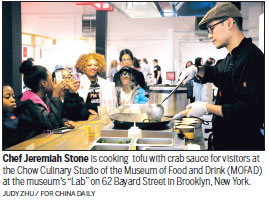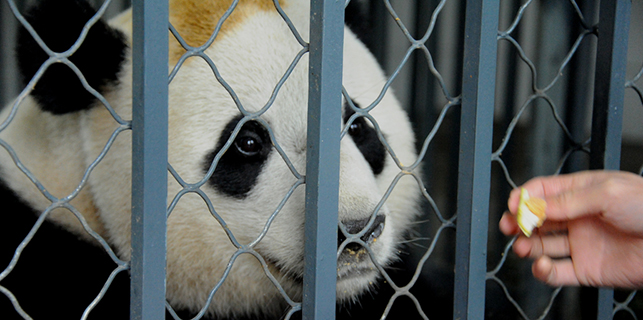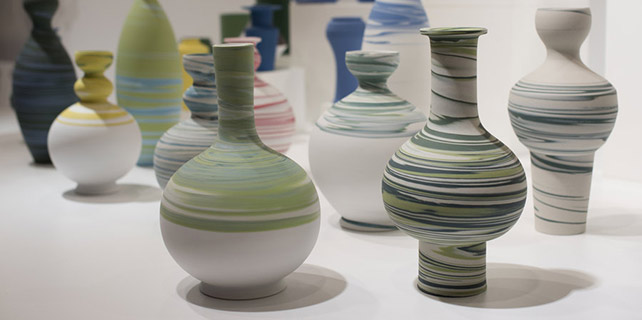Museum exhibit tells glorious tale of Chinese-American restaurants

The story of Chinese cuisine in the US is a long one, a tale of perseverance against prejudice that culminates in the Chinese restaurant cementing its place in the American culinary tradition.
That history unfolds in Chow: Making the Chinese American Restaurant, an exhibition designed and curated by the Museum of Food and Drink (MOFAD) at the museum's "Lab" on 62 Bayard Street in Brooklyn.
The exhibition celebrates the birth and evolution of Chinese-American restaurants, tracing their nearly 170-year history and sparking conversations about food culture, immigration, and what it means to be Chinese American.
"Chow" is how "stir-frying" is pronounced in Cantonese.
"It all starts with the first wave of immigration from China, which happened at the Gold Rush, and most of these immigrants were Cantonese," said Peter Kim, executive director of MOFAD.
Those immigrants stayed after the Gold Rush to work on the railroads, "and after that, they sort of competed with other Americans for jobs. This is when we saw a pretty ugly backlash against the Cantonese who were in the US", Kim said.
"There's a lot of racial discrimination, a lot of violence, and the government enacted a law called the Chinese Exclusion Act, which actually banned immigration from China for over 60 years," he said.
The exhibition explains how the Chinese suffered under the law and the harsh conditions they lived under in the US; how they persevered and created an entirely new cuisine, for which they adapted Chinese recipes and made them as appealing as possible for non-Chinese diners.
"In honor of the contributions of these first immigrants who faced such a difficult time, we named the exhibition 'Chow' because (in) the culinary (tradition) they brought from China, stir-frying is a technique we still see in Chinese-American restaurants to this day," Kim said.
in Chinese-American restaurants to this day," Kim said.
To show visitors how popular Chinese-American restaurants are in the United States, an installation named "curtain of many", a curtain made up of 7,250 takeout boxes, is on prominent display at the venue.
"Each of the boxes represents seven Chinese-American restaurants in the US, and in total, it represents 50,000 Chinese-American restaurants you can find from coast to coast. And to put that in perspective, that is three times more than the number of McDonald's (that) are in the US," Kim said.
After entering the lab, visitors can immerse themselves in a timeline of Chinese-American restaurant menus dating to 1910, which shows the evolution of the cuisine by decade.
Ronald Yee, 60, came across the menu of the Fulton Royal Restaurant in Brooklyn while browsing the exhibition.
"That's where my dad worked right after World War II, and he got started over there; that's a long story," Yee said with excitement.
"It's an excellent exhibition, full of food culture and a lot of history. Looking at all the menus, because many of my relatives own Chinese restaurants, some in Canada as well as the United States, a lot of these menus bring back memories," said the retired senior train master for Metro-North Railroad.
"People really love the menus; it's a really fun way to look at dishes through time and find places that you recognize," said Catherine Piccoli, the museum's program manager.
"But what touches me the most is that people get it, they see the parallels to what's going on in the world today and in our country today and also leave here saying, 'I'm going to think about my local Chinese spot differently,' like have a much larger understanding of all that goes into that has gone into the cuisine historically and the people that are working there as well," Piccoli added.
The Chow Culinary Studio invited famed Chinese-American chefs, including Doron Wong (Northern Tiger), Jonathan Wu (Fung Tu), Jeremiah Stone (Contra/Wildair), Irene Li (Mei Mei), Chris Cheung (East Wind Snack Shop) and Lee Anne Wong (Koko Head Cafe) to demonstrate cooking.
Another highlight of the show is a 1,500-pound fortune cookie machine, which is in continuous operation in a corner of the venue, fulfilling the so-called "Project Fortune".
The museum is collecting messages of goodwill from people around the world and putting them into the cookie, in an approach similar to a message in a bottle.
"So what we've seen is visitors come, and they have sort of an emotional connection with the topic of the exhibition, but what we then do is we reveal these incredible stories of hardship and adaptation behind the restaurant, and I think that is what is so powerful about Chow," Kim said.
The exhibition will be open this summer Friday to Sunday.
xiaohong@chinadailyusa.com
















